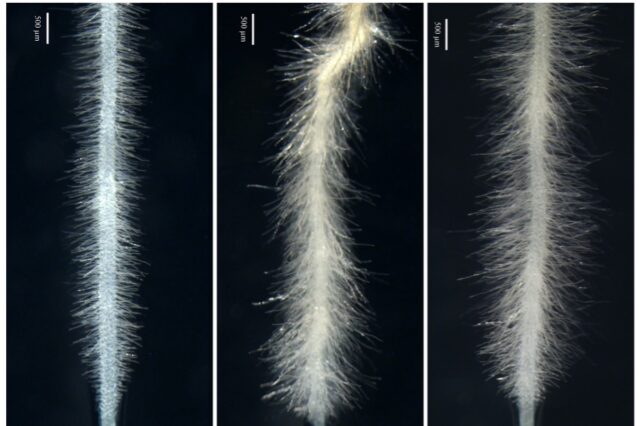
After inoculation with Serendipita fungi, switchgrass root hairs increase in density and surface area. Credit: Prasun Ray et al., IS-MPMI.*
Serendipita fungus has a special relationship with plants. When it colonizes the roots of switchgrass, the fungus does not hurt the plant. In fact, it has been shown to increase the plant’s drought tolerance, seed germination and yield. But the signaling between the two partners that helps establish and maintain this symbiotic relationship has not been well understood.
Switchgrass is an important bioenergy crop for cellulosic ethanol production because switchgrass flourishes even in poor soil where food crops will not grow. A recent study coordinated by the Center for Bioenergy Innovation (CBI) investigated the molecular steps of how switchgrass responds at the cellular level to colonization by two strains of Serendipita fungi.
“When a fungus comes in close contact with a plant, a signaling system helps plants recognize its approach,” said lead researcher Prasun Ray. “Both good and bad fungi release signaling molecules. During this release, the plant either fights back or surrenders. We tried to understand this process, step by step, in the different stages: how a plant recognizes the fungus before the infection, then how it reacts during infection, then how it behaves after infection and one month later.”
Scientists analyzed how RNA molecules led switchgrass cells to make chemical and structural changes in response to the fungi. Most of the research was conducted by the Nobel Research Institute, with gene sequencing performed by the Joint Genome Institute, a Department of Energy Office of Science user facility.
Analysis showed that only slight genetic changes were necessary to establish a relationship between the plant and fungus. The approach of the fungus led the plant to increase its root hair density and root surface area, essentially making it easier to absorb nutrients and admit beneficial microbes. Once the fungus entered the plant, switchgrass quenches its defenses and adjusts its metabolism to accommodate its partner.
Ray said this was one of the most interesting results of the experiment. “We found that when this fungus tries to enter the plant root system, the defense system of the plant is actually reduced. It’s like the plant opens a gate and allows the fungus in, then shuts the gate.” Collectively, these findings suggest that Serendipita fungi, which had not previously been studied in depth, can circumvent the defense response machinery of a host to establish a mutually beneficial relationship.
These findings lay a foundation for improving row crop, forage crop and perennial harvests by deliberately pairing fungi with the plants. This is particularly promising for biofuel feedstock crops.
“You can use switchgrass on marginal land, so it doesn’t compete with food crops,” said Ray, who is a visiting associate professor at the University of Maryland Eastern Shore. “Instead of adding chemical fertilizer such as nitrogen and phosphorous, which is not a very sustainable solution, you could use the fungus and be much more sustainable.”
This approach has the advantage of reducing costs while avoiding the use of unnecessary chemicals in the landscape. In addition, Ray said, “When you put this fungus in the soil in association with the plant root system, it has the potential to mitigate greenhouse gas and sequester soil carbon in a very efficient way.”
Meeting U.S. goals for replacing 30 percent of petroleum consumption with biofuels by 2030 will require approximately 1 billion dry tons of biomass feedstock a year. Understanding and using these natural processes could help achieve this goal.
CBI at Oak Ridge National Laboratory is one of four Department of Energy Bioenergy Research Centers focused on advancing biofuels and bioproducts for a vibrant domestic bioeconomy. CBI is accelerating the development of bioenergy-relevant plants and microbes to enable production of drop-in sustainable aviation fuel, bioproducts that sequester carbon, and sustainable replacements for plastics and other environmentally harmful products. CBI research is supported by the Biological and Environmental Research program in DOE’s Office of Science.
*Prasun Ray et al., IS-MPMI. Excerpt of the original, used under CC by 4.0
